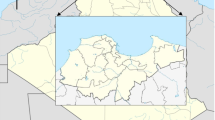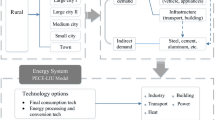Abstract
This paper calculates the energy consumption and CO2 emissions of Bei**g over 2005–2011 in light of the Bei**g’s energy balance table and the carbon emission coefficients of IPCC. Furthermore, based on a series of energy conservation planning program issued in Bei**g, the Long-range Energy Alternatives Planning System (LEAP)-BJ model is developed to study the energy consumption and CO2 emissions of Bei**g’s six end-use sectors and the energy conversion sector over 2012–2030 under the BAU scenario and POL scenario. Some results are found in this research: (1) During 2005–2011, the energy consumption kept increasing, while the total CO2 emissions fluctuated obviously in 2008 and 2011. The energy structure and the industrial structure have been optimized to a certain extent. (2) If the policies are completely implemented, the POL scenario is projected to save 21.36 and 35.37 % of the total energy consumption and CO2 emissions than the BAU scenario during 2012 and 2030. (3) The POL scenario presents a more optimized energy structure compared with the BAU scenario, with the decrease of coal consumption and the increase of natural gas consumption. (4) The commerce and service sector and the energy conversion sector will become the largest contributor to energy consumption and CO2 emissions, respectively. The transport sector and the industrial sector are the two most potential sectors in energy savings and carbon reduction. In terms of subscenarios, the energy conservation in transport (TEC) is the most effective one. (5) The macroparameters, such as the GDP growth rate and the industrial structure, have great influence on the urban energy consumption and carbon emissions.











Similar content being viewed by others
Notes
Only road transport is considered in the transport sector because its high influence on total energy consumption and the civil aviation and railway are not included in our study.
The “even and odd-numbered license plates” limit means that for one certain motor vehicle, it is only permitted to run on the driveway in every 2 days depending on whether the license plate number is even or odd. For example, on Monday, Wednesday, and Friday, only motor vehicles with even license plate number can be used on the driveway and those with odd license plate number are permitted to be used on Tuesday and Thursday.
The industrial structure adjustment also belongs to the uncertainty of the implementation of measures and policies.
References
Arnold, M., & Barth, V. (2012). Open innovation in urban energy systems. Energy Efficiency, 5(3), 351–364.
Bei**g Statistical Bureau (2006–2012). Bei**g Statistical Yearbook (2006–2012). Bei**g: China Statistics Press. (In Chinese).
Bi, J., Zhang, R., Wang, H., Liu, M., & Wu, Y. (2011). The benchmarks of carbon emissions and policy implications for China’ cities: case of Nan**g. Energy Policy, 39(2011), 4785–4794.
Bohringer, C., & Rutherford, T. F. (2009). Integrated assessment of energy policies: decomposing top-down and bottom-up. Journal of Economic Dynamics and Control, 33, 1648–1661.
Cai, W. J., Wang, C., Chen, J. N., Wang, K., Zhang, Y., & Li, X. D. (2008). Comparison of CO2 emission scenarios and mitigation opportunities in China’s five sectors in 2020. Energy Policy, 36(2008), 1181–1194.
Cai, Z., Ou, X., Zhang, X., Zhang, X., He, J., & **ng, Y. (2013). Comparative study of energy consumption and CO2 emissions between Bei**g and London. Frontiers in Energy, 7(1), 1–5.
de la Rue de Can, S., & Price, L. (2008). Sectoral trends in global energy use and greenhouse gas emissions. Energy Policy, 36(2008), 1386–1403.
Dhakal, S. (2003). Implications of transportation policies on energy and environment in Kathmandu Valley, Nepal. Energy Policy, 31(2003), 1493–1507.
Dhakal, S. (2009). Urban energy use and carbon emissions from cities in China and policy implications. Energy Policy, 37(2009), 4208–4219.
Fan, J.-L., Liao, H., Liang, Q.-M., Tatano, H., Liu, C.-F., & Wei, Y.-M. (2013). Residential carbon emission evolutions in urban–rural divided China: an end-use and behavior analysis. Applied Energy, 101(2013), 323–332.
Feng, Y. Y., & Zhang, L. X. (2012). Scenario analysis of urban energy saving and carbon abatement policies: a case study of Bei**g city, China. Procedia Environmental Sciences, 13(2012), 632–644.
Feng, Y. Y., Chen, S. Q., & Zhang, L. X. (2013). System dynamics modeling for urban energy consumption and CO2 emissions: a case study of Bei**g, China. Ecological Modelling, 252(2013), 44–52.
Gomi, K., Shimada, K., & Matsuoka, Y. (2010). A low-carbon scenario creation method for a local-scale economy and its application in Kyoto city. Energy Policy, 38(2010), 4783–4796.
Huang, C., Chen, C. H., Wang, B. Y., Dai, Y., Zhao, J., & Wang, H. K. (2005). Urban travel modal split and its impact on energy and environment. Journal of Highway and Transportation Research and Development, 22(11), 163–166 (In Chinese).
IPCC. (2006). 2006 IPCC Guidelines for National Greenhouse Gas Inventories: volume II: energy. Japan: Institute for Global Environmental Strategies.
IPCC. (2007). IPCC fourth assessment report (AR4). London: Cambridge University Press.
Li, L., Chen, C., **e, S., Huang, C., Cheng, Z., Wang, H., et al. (2010). Energy demand and carbon emissions under different development scenarios for Shanghai, China. Energy Policy, 38(2010), 4797–4807.
Limmeechokchaia, B., & Chawana, S. (2007). Sustainable energy development strategies in the rural Thailand: the case of the improved cooking stove and the small biogas digester. Renewable Sustainable Energy Review, 11(5), 818–837.
Lin, J., Cao, B., Cui, S., Wang, W., & Bai, X. (2010). Evaluating the effectiveness of urban energy conservation and GHG mitigation measures: the case of **amen city, China. Energy Policy, 38(2010), 5123–5132.
Mi, Z.-F., Pan, S.-Y., Yu, H., & Wei, Y.-M. (2014). Potential impacts of industrial structure on energy consumption and CO2 emission: a case study of Bei**g. Journal of Cleaner Production in press.
National Bureau of Statistics P.R. China. (2012). China energy statistical yearbook (2012). Bei**g: China Statistics Press (In Chinese).
Olivier, J.G.J., Janssens-Maenhout, G., Muntean, M., & Peters, J.A.H.W. (2013). (PBL) Trends in global CO2 emissions. PBL Netherlands Environmental Assessment Agency, Hague, Netherlands. ISBN: 978-94-91506-51-2.
Parshall, L., Gurney, K., Hammer, S. A., Mendoza, D., Zhou, Y., & Geethakumar, S. (2010). Modeling energy consumption and CO2 emissions at the urban scale: methodological challenges and insights from the United States. Energy Policy, 38(2010), 4765–4782.
Phdungsilp, A. (2010). Integrated energy and carbon modeling with a decision support system: policy scenarios for low-carbon city development in Bangkok. Energy Policy, 38(2010), 4808–4817.
Pradhan, S., Ale, B. B., & Amatya, V. B. (2006). Mitigation potential of greenhouse gas emission and implications on fuel consumption due to clean energy vehicles as public passenger transport in Kathmandu Valley of Nepal: a case study of trolley buses in Ring Road. Energy, 31(12), 1748–1760.
Roger, P. J., Wigley, T., & Green, C. (2008). Dangerous assumptions. Nature, 452, 531–532.
Rutter, P., & Keirstead, J. (2012). A brief history and the possible future of urban energy systems. Energy Policy, 50(2012), 72–80.
Shin, H.-C., Parka, J.-W., Kim, H.-S., & Shin, E.-S. (2005). Environmental and economic assessment of landfill gas electricity generation in Korea using LEAP model. Energy Policy, 33(2005), 1261–1270.
Solomon, S., Plattner, G.-K., Knutti, R., & Friedlingstein, P. (2009). Irreversible climate change due to carbon dioxide emissions. PNAS, 106, 1704–1709.
Steemers, K. (2003). Energy and the city: density, buildings and transport. Energy and Buildings, 35(2003), 3–14.
Stockholm Environment Institute (SEI). (2011). User guide, LEAP: long range energy alternative planning system. Boston: Stockholm Environment Institute.
Wang, Q. Y. (2006). The energy conservation handbook 2006. Energy conservation and environmental protection. Bei**g: Magazine (In Chinese).
Wang, K., Wang, C., Lv, X., & Chen, J. (2006). Abatement potential of CO2 emissions from China’s iron and steel industry based on LEAP. Journal of Tsinghua University (Science and Technology), 46(12), 1982–1986 (In Chinese).
Wang, Z., Yin, F., Zhang, Y., & Zhang, X. (2012). An empirical research on the influencing factors of regional CO2 emissions: evidence from Bei**g city, China. Applied Energy, 100(2012), 277–284.
World Bank (2010). Cities and climate change: an urgent agenda. Washington DC.
**, F., Geng, Y., Chen, X., Zhang, Y., Wang, X., Xue, B., et al. (2011). Contributing to local policy making on GHG emission reduction through inventorying and attribution: a case study of Shenyang, China. Energy Policy, 39(2011), 5999–6010.
Ye, Y.-L., & Han, Y.-D. (2010). Effect of industrial development on energy intensity in Bei**g. Journal of North China Electric Power University (Social Sciences), 3, 16–20 (In Chinese).
Yu, H., Yang, R., Zhang, Y., & Wang, S. (2013). Study on the energy demand and environmental emissions of urban transport—acase study of Bei**g. Journal of Bei**g Institute of Technology (Social Sciences edition), 15(5), 10–15 (In Chinese).
Zhang, X. P. (2005). Temporal-spatial characteristics of energy consumption in China and its determinants since the 1990s. China Population, Resources and Environment, 15, 38–41 (In Chinese).
Zhang, Q. Y., Tian, W. L., Wei, Y. M., & Chen, Y. X. (2007). External costs from electricity generation of China up to 2030 in energy and abatement scenarios. Energy Policy, 35(2007), 4295–4304.
Zhang, J., Zhang, Y., Yang, Z., Fath, B. D., & Li, S. (2013). Estimation of energy-related carbon emissions in Bei**g and factor decomposition analysis. Ecological Modelling, 252(2013), 258–265.
Zhou, D.,Levine, M., Dai, Y., Yu, C., Guo, Y., Sinton, J.E., et al. (2004). China’s sustainable energy future: scenarios of energy and carbon emissions (summary). Lawrence Berkeley National Laboratory. Paper LBNL-54067. <http://repositories.cdlib.org/lbnl/LBNL-54067>.
Zhou, J., Cui, S. H., Lin, J. Y., & Li, F. (2011). LEAP based analysis of transport energy consumption and air pollutants emission in **amen city. Environmental Science and Technology, 34(11), 164–170 (In Chinese).
Acknowledgments
The authors gratefully acknowledge the financial support from National Natural Science Foundation of China (71020107026), the “Strategic Priority Research Program” of the Chinese Academy of Sciences (XDA05150600), National Basic Research Program of China under the Grant No. 2012CB955704.
Author information
Authors and Affiliations
Corresponding author
Rights and permissions
About this article
Cite this article
Yu, H., Pan, SY., Tang, BJ. et al. Urban energy consumption and CO2 emissions in Bei**g: current and future. Energy Efficiency 8, 527–543 (2015). https://doi.org/10.1007/s12053-014-9305-3
Received:
Accepted:
Published:
Issue Date:
DOI: https://doi.org/10.1007/s12053-014-9305-3




